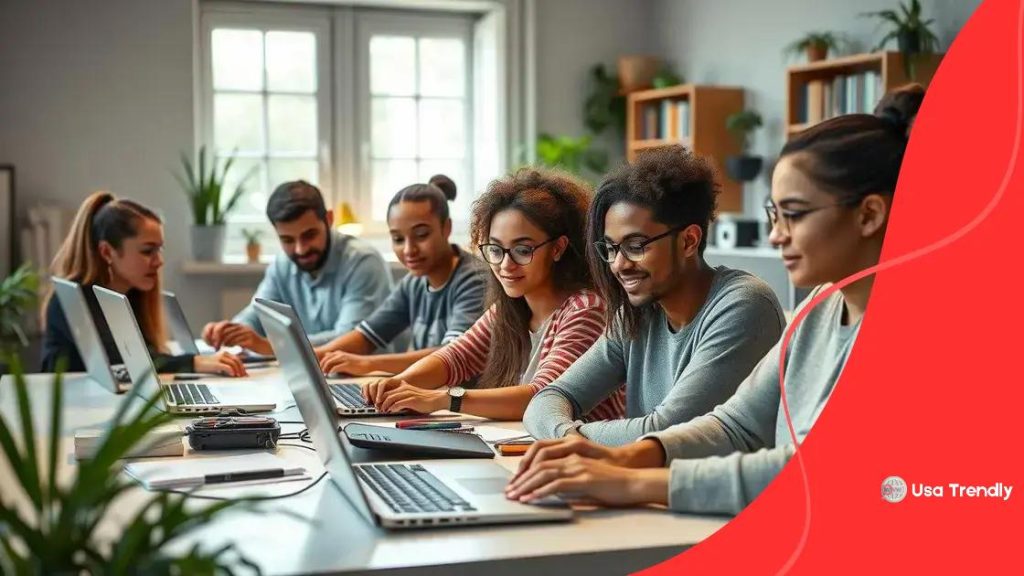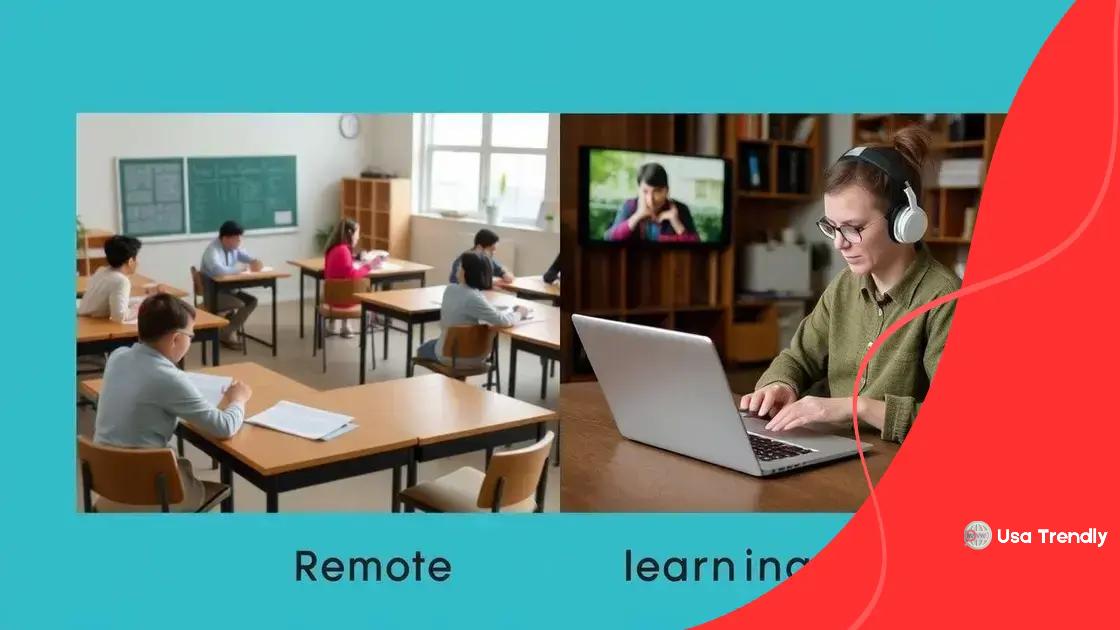Remote learning effectiveness evaluated: what you need to know

Remote learning effectiveness is determined by factors such as technology access, instructor support, and interactive engagement strategies, making it a viable alternative to traditional education when implemented thoughtfully.
Remote learning effectiveness evaluated is a crucial topic in today’s educational landscape. Many have experienced this shift firsthand, but what does it really mean for learning outcomes?
Understanding remote learning effectiveness
Understanding remote learning effectiveness is essential for educators and students alike. Today, many schools and institutions utilize technology to deliver education from a distance. But how effective is this method?
To truly grasp the effectiveness of remote learning, we must explore key factors that play a crucial role in its success. One critical aspect is student engagement. When students are engaged, they retain information better and perform well academically. Another vital factor is the quality of resources provided. High-quality materials and interactive content can enhance the learning experience significantly.
Key Factors Influencing Success
Several key factors contribute to the effectiveness of remote learning. These include:
- Technology access: Students must have reliable access to computers or tablets and the internet.
- Instructor support: Effective communication and support from teachers foster a positive learning environment.
- Structured schedules: Regular schedules help students stay organized and focused on their studies.
- Peer interaction: Collaborative activities promote teamwork and make learning more enjoyable.
Moreover, comparing remote learning to traditional methods can shed light on its strengths and weaknesses. While face-to-face interactions in classrooms have their benefits, remote learning provides flexibility that traditional settings often lack. For instance, students can learn at their own pace and access materials from anywhere.
Real-World Examples of Effective Remote Learning
Many educational institutions have successfully implemented remote learning strategies. For example, schools that use dedicated online platforms allow students to interact in real-time during classes. This format mimics traditional classes while offering the advantages of technology.
Additionally, utilizing various multimedia resources—like videos, quizzes, and interactive lessons—can significantly improve student engagement. For instance, a teacher might create a video lesson for visual learners and follow it up with an interactive quiz. This approach caters to diverse learning styles, enhancing the overall effectiveness of remote learning.
Understanding these elements helps educators and institutions make informed decisions. By focusing on the factors that influence remote learning effectiveness, they can create a more engaging and productive online learning environment.
Key factors influencing success
Key factors influencing success in remote learning are essential to understand if we want to enhance this educational method. Various elements contribute to how well students perform when learning from home.
One primary factor is access to technology. Without reliable internet and devices, students may struggle to keep up with their coursework. Schools should ensure that all students have the tools they need to succeed. Another important aspect is the level of support students receive from instructors. Teachers play a vital role in guiding and motivating their students in a remote setting.
Factors Critical to Success
Several factors impact the effectiveness of remote learning:
- Structured learning environment: A well-organized schedule helps students stay focused and on track.
- Active participation: Encouraging students to engage in discussions boosts their understanding and retention of information.
- Feedback mechanisms: Regular feedback from instructors helps students identify areas for improvement and builds their confidence.
- Parental involvement: Support from parents or guardians can greatly enhance a student’s learning experience by providing motivation and assistance.
Furthermore, the methods used in remote learning can significantly affect student outcomes. For example, incorporating interactive content, such as quizzes or group projects, can make lessons more engaging. This not only keeps students interested but also helps them grasp concepts more effectively.
Enhancing Remote Learning
Creating a community among students is another critical aspect. When students feel connected to their peers and teachers, they are more likely to participate actively. Schools can facilitate this by offering virtual study groups or discussion forums. These connections help students feel less isolated and more engaged in their learning.
In summary, understanding and addressing these key factors can lead to significantly better outcomes in remote learning. By focusing on technology access, support from instructors, and student engagement, we can enhance the effectiveness of education at a distance.
Comparison with traditional learning

Comparison with traditional learning showcases the unique challenges and benefits that remote learning presents. Each method of education has its strengths that can cater to different learning styles.
One significant difference is the flexibility offered in remote learning. Students have the option to attend classes from anywhere, which can be especially advantageous for those with jobs or family obligations. Unlike traditional learning, where attendance is often mandatory in person, remote learning allows students to choose their learning environment. This flexibility can lead to improved focus and better retention.
Advantages of Traditional Learning
While remote learning has many benefits, traditional learning also offers unique advantages. These include:
- Face-to-face interaction: Students can build relationships with teachers and peers, fostering a sense of community.
- Structured environment: Classrooms provide a dedicated space for learning, free from home distractions.
- Hands-on experiences: Certain subjects, like science or art, often benefit from in-person demonstrations and collaborative projects.
Additionally, remote learning may struggle with engagement. In a physical classroom, teachers can read body language and respond to students in real time. This immediate feedback can help students feel connected and keep them involved. On the contrary, in remote settings, students may feel isolated, leading to decreased motivation and participation.
Challenges of Remote Learning
One challenge for remote learning is ensuring access to technology. Not all students have reliable internet or devices at home, creating a gap in learning opportunities. Furthermore, the lack of direct supervision can also lead to difficulties in maintaining focus. Many students may find it hard to stay disciplined without the presence of a teacher nearby.
However, technology also offers tools to enhance engagement through interactive platforms. Educators can use various online tools to create a dynamic learning environment, such as discussion boards, virtual simulations, and online quizzes. This interactivity can compensate for some isolation felt in remote learning.
Overall, the comparison between remote and traditional learning highlights different experiences. Each method has elements to share, and understanding their strengths and weaknesses can improve educational outcomes for all students.
Real-world examples of effective remote learning
Real-world examples of effective remote learning show how various schools and organizations adopt innovative strategies to enhance education. These instances provide valuable insights into what works and how these approaches benefit students.
One notable example is the use of interactive platforms by many universities. Colleges have embraced online learning tools that allow students to participate in live classes, engage in discussions, and collaborate on projects in real-time. These platforms have made learning more accessible, even for remote students.
Successful Implementations
Some successful implementations include:
- Virtual labs: Science courses have adapted by using virtual labs, enabling students to conduct experiments online. This method maintains the hands-on experience while being safe and convenient.
- Online study groups: Schools have encouraged the formation of virtual study groups where students can connect via video calls to discuss assignments and study together.
- Flipped classrooms: In this approach, students learn new content at home through video lectures and then apply that knowledge during live sessions with teachers.
Another effective strategy involves assessment innovations. Some educational institutions have shifted to online assessments that adapt to the student’s skill level. This personalized approach helps accurately gauge a student’s understanding of the material.
Engaging Content Delivery
Engaging content delivery also plays a crucial role. Schools using gamification strategies report higher student participation and enthusiasm. By incorporating game elements like badges and leaderboards, students feel motivated to complete assignments and achieve their learning goals.
Furthermore, teachers are finding creative ways to maintain connection with students. Weekly check-ins through video calls help keep students motivated, providing them with personalized support and guidance. These sessions allow students to express any challenges they may face, ensuring they feel supported during their learning journey.
Overall, these real-world examples of effective remote learning highlight how flexibility, innovation, and engagement positively impact educational outcomes. Every successful approach contributes to a more enriching experience for students.
Strategies to enhance remote engagement
Strategies to enhance remote engagement are vital for maintaining student interest and motivation in virtual learning environments. Effective engagement can make a significant difference in academic performance and overall satisfaction.
One successful strategy is using interactive tools. These can include quizzes, polls, and discussion boards that encourage active participation during lessons. When students are involved in their learning process, they are more likely to retain information and feel connected to the material.
Techniques to Foster Engagement
Several techniques can further enhance engagement:
- Gamification: Incorporating game elements, such as points and badges for completing activities, can make learning more fun and motivating.
- Breakout rooms: In virtual classrooms, using breakout rooms for group discussions allows students to collaborate and form connections with peers.
- Regular check-ins: Frequent individual or group check-ins help build relationships and allow teachers to address students’ concerns in real-time.
An additional strategy is to provide personalized feedback. When instructors offer tailored feedback on assignments or contributions, students feel valued and recognized. This practice can lead to greater efforts in subsequent activities.
Creating a Supportive Environment
Also, creating a supportive environment is crucial for engagement. Encouraging open lines of communication allows students to express their thoughts and questions freely. Teachers might dedicate time during each class for students to share their ideas and experiences, fostering a sense of community.
Utilizing a mix of content delivery methods keeps lessons exciting. This might include videos, live demonstrations, and collaborative projects that cater to different learning styles. When students encounter varied materials, they are likely to remain engaged and interested in the subject matter.
Ultimately, implementing these strategies not only enhances remote engagement but also contributes to a richer learning experience. By actively involving students and creating a responsive environment, educational institutions can significantly improve remote learning outcomes.
FAQ – Frequently Asked Questions about Remote Learning Effectiveness
What are the key factors for successful remote learning?
Key factors include access to technology, instructor support, student engagement, and structured learning environments.
How can gamification enhance remote learning?
Gamification incorporates game elements like points and badges, making learning more enjoyable and motivating for students.
What strategies can improve student engagement?
Strategies such as interactive tools, regular check-ins, and personalized feedback significantly enhance student engagement.
Can remote learning be as effective as traditional learning?
Yes, when approached thoughtfully with effective strategies, remote learning can provide comparable results to traditional classroom settings.
SEE MORE CONTENT